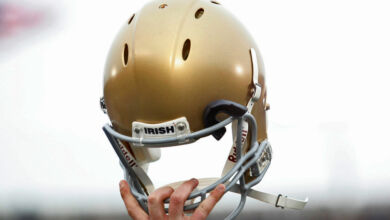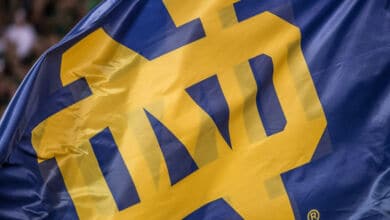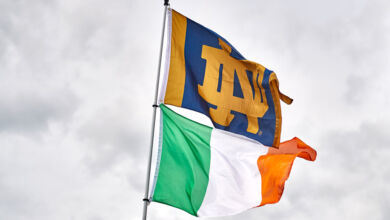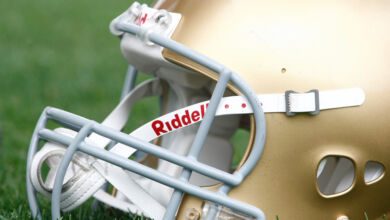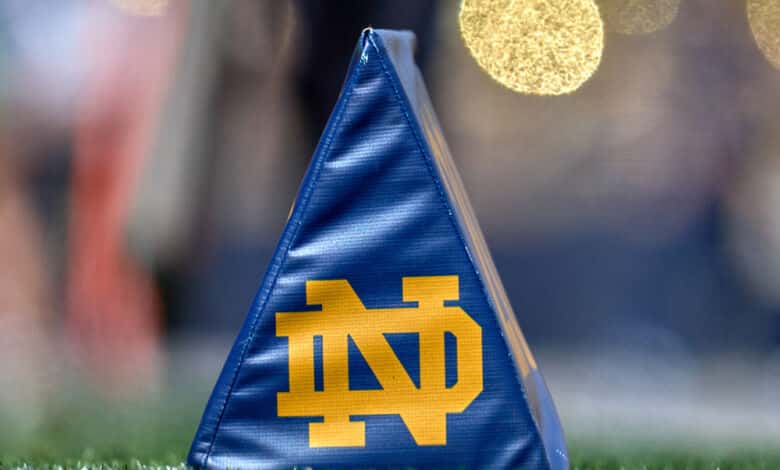
The Notre Dame Fighting Irish didn’t manage to capture the 1970 national championship. However, they did have a major role in making sure that the Texas Longhorns didn’t win a second consecutive title. The 24-11 New Year’s Day 1971 win over those Longhorns in the Cotton Bowl served as a satisfying cap to a 10-1 season. It also gained a measure of revenge for the heartbreaking loss in that same bowl to Texas the year before.
During that 1970 campaign, the Irish worked their way up for a one-week stay as the top-ranked team. However, tight victories over Georgia Tech and LSU, followed by a loss in the regular season finale at rival Southern Cal dropped them to sixth, back where they’d started the season.
Texas entered this contest with a 30-game winning streak and was hoping for some deja vu after defeating Notre Dame the year before in dramatic fashion. Like many teams in that era, the Longhorns’ heavy reliance on the running game, with the Irish defense facing a ground game that averaged over 400 yards per contest.
The Coaches: Parseghian vs. Royal
Legendary Notre Dame coach Ara Parseghian was set to complete his seventh season as head coach at Notre Dame and had one national title to his credit. That 1966 championship had a tinge of controversy attached to it, with the three subsequent seasons each seeing the Irish finish with two losses. For Notre Dame to have any hope of winning the 1970 national title, they needed to start with a win over Texas. From there, some upsets of the teams ahead of required a miracle of good fortune.
Darrell Royal was in his 14th season as head coach of the Longhorns and was on the verge of capturing his third national title. Royal managed to get past the pressure of being defending champions by leading the Longhorns to wins in 10 regular season games. That challenge was lessened by the fact that Texas’ only two games against ranked teams were played at home in Austin.
Key Players: Theismann Leads the Charge
Joe Theismann was in his second and final season starting at quarterback for the Irish, finishing second to Jim Plunkett in the Heisman balloting. Theismann was one of a host of running options that also included Ed Gulyas and Denny Allan, though his main weapon on offense was wide receiver Tom Gatewood. The Notre Dame defense was led by defensive lineman Mike Kadish, linebacker Tim Kelly and cornerback Clarence Ellis.
The Longhorns’ potent wishbone attack was often unstoppable, with quarterback Eddie Phillips just one of the weapons that Royal unleashed. Phillips was joined by running backs Steve Worster and Jim Bertelsen to rush for a combined total of 2,455 yards that season. On defense, end Bill Atessis and linebacker Bill Zapalac helped Texas limit opponents to just 11 points per game.
The Game: Irish Overcome Odds to Triumph
- Notre Dame entered the game as underdogs, missing All-American Larry DiNardo, while Texas faced injuries to key players.
- Texas started with a 63-yard run by Phillips but settled for a field goal after a fumble.
- Joe Theismann led Notre Dame to a 14-3 lead with a touchdown pass to Tom Gatewood and a three-yard run.
- Theismann’s 15-yard run increased the lead to 21-3; Texas responded with an 18-play drive, making it 21-11.
- Notre Dame added a field goal before halftime for a 24-11 lead.
- Notre Dame’s defense and Texas’ fumbles in the second half secured the Irish victory.
Notre Dame entered this matchup as six-point underdogs and was going to have to play without All-American guard Larry DiNardo, who had undergone knee surgery. Kadish’s shoulder was also an issue, while the Longhorns had their own issues with injuries to Worster and wide receiver Cotton Speyrer.
At the outset, the Irish were immediately knocked on their heels when Phillips broke off a 63-yard run on the first play from scrimmage. That put the ball at the Notre Dame 10, but the Irish stiffened and held Texas to a 23-yard field goal. The first of what turned out to be many miscues for the Longhorns came when Phillips’ pitch to Bertelsen on the next play was bobbled out bounds, negating a clear path to the end zone.
Notre Dame didn’t take long to respond as Theismann drove the Irish 80 yards on 10 plays and connected with Gatewood on a 26-yard scoring toss on fourth down. Just after the catch at the Texas 10, Gatewood pulled a hamstring and limped into the end zone for the go-ahead score.
On the ensuing kick, the Longhorns fumbled the ball away at their own 13 and Theismann needed just six plays to give the Irish a 14-3 advantage. His three-yard bootleg required some maneuvering but got him into the end zone.
Theismann’s legs meant more points for Notre Dame at the start of the second quarter as he dodged tacklers for a 15-tard scoring dash to give the Irish a commanding 21-3 advantage. However, Texas wasn’t ready to concede the game and eventually sliced their deficit back down to 10 with just under two minutes to go. The 18-play, 84-yard drive was capped by a two-yard run from Bertlesen, followed by a two-point conversion to make it 21-11.
The Irish would tally the final points of the game just before halftime when a two-minute drill featuring three different Notre Dame signal-callers drove to the Texas 20. That allowed Scott Hempel to loft a 36-yard field goal to make it 24-11. One key play in the drive was when reserve quarterback Jim Bolger found Clarence Ellis for the latter’s first-ever offensive reception for the Irish.
Two reasons why the Longhorns weren’t able to score again related to the stifling Irish defense as well as their own problems holding onto the ball. Two costly fumbles by Worster stopped third-quarter drives, while Notre Dame made a stop on fourth down at their own 35. Later, the Irish added another fumble recovery at their own four-yard-line.
Aftermath: Close but No National Title
For Notre Dame to have any hope of a national title, they first needed help from their new rival Stanford, who the Irish started playing yearly in 1963, to upset Ohio State in the Rose Bowl and then have LSU to knock off Nebraska. Stanford did manage to defeat Ohio State, which meant that an LSU victory was conceivably all that stood between the Irish and another title.
Unfortunately, Nebraska held on for a 17-12 win over LSU to finish 10-0-1 on the season and win the first of two straight national championships. The Irish did manage to move up to the second spot, though it’s doubtful that provided any solace to Parseghian’s squad.
Notre Dame wouldn’t return to the Cotton Bowl for another seven years and had a much happier outcome in that clash. They again dominated a top-ranked Texas squad, winning 38-10, and were able to work their way up the ladder as key upsets forged a path to the national title.
